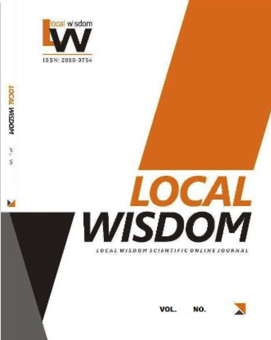Returning to Nothing: The Lost of Malay Settlement in Pasir Mas, Kelantan.
DOI:
https://doi.org/10.26905/lw.v14i2.6748Keywords:
Malay Settlement, Lost of Place, Pasir MasAbstract
Natural calamities such as earthquakes, landslides, windstorms, and floods are considered disasters according to the degree of disruption they caused to the human population, built environment, or natural ecosystem. Natural disasters are a common occurrence in rural settlements of Malaysia, affecting the lives of the rural population and damaging the rural settlements, agriculture, roads, drainage schemes, and other infrastructure. This threat continues to exist, and disasters are still wreaking havoc in rural areas. However, this disaster is compounded by the current rate of urbanization in the region. Human life conjures a spatial location due to the unique combination of movement and strength that characterizes humans. Humans, unlike trees, are not stationary; yet they require more manmade shelters than other animals, and communities. Humans, in particular, share their space. A loss narrative defines today's place literature: specifically, the loss of the correct link between place and meaning (Cox, 1968; Lynch, 1972; Jacobs & Appleyard, 1987; Kunstler, 1993). Simultaneously, this article aims to investigate the disappearance of Malay settlements and discuss some of the implications. In February 2021. a landslide event took place in Pasir Mas, Kelantan. It is an area where researchers used to spend their youth. The objective of this article is to provide a perspective on the disappearance of Malay settlement by studying two theories, namely natural calamity and Malay settlement. The entire idea of this article is the transformation of the components of place characterized by the narrative of loss has enormous planning and design implications, two of which are central here: firstly, the emergence of geographies of place, and secondly, the loss of Malay culture crisis.
Downloads
References
Agnew, J. (1984) Devaluing place: 'people prosperity versus place prosperity' and regional planning, Environment and Planning D: Society and Space, 1, pp. 35-45.
Altman, I., (1975). The Environment and Social Behavior: Privacy, Personal Space, Territory, Crowding. Monterey Calif: Brooks/ Cole Pub. Co.
Altman, I., & Low., S. (1992). (Eds) place Attachment. New York; Premium Press.
Arefi, M. (1999). Nonâ€place and placelessness as narratives of loss: Rethinking the notion of place. Journal of Urban Design, 4(2), 179–193. doi:10.1080/13574809908724445
Balocco, C., & Calzolari, R. (2008). Natural Light Design for an Ancient Building: A Case Study. Journal of Cultural Heritage. Journal of Cultural Heritage 9 (2008) 172e178. All rights reserved.doi:10.1016/j.culher. Elsevier Masson SAS.
Brehm, J. M., Eisenhauer, B. W., & Stedman, R. C. (2013). Environmental Concern: Examining the Role of Place Meaning and Place Attachment. Society & Natural Resources. 26(5), 522–538. Society and Natural Resources, 26:522–538. Taylor & Francis Group. ISSN: 1521-0723 online. DOI: 10.1080/08941920.2012.715726.
Bickford, S. (2000). Constructing Inequality. City Space and the Architecture of Citizenship. Political Theory, Volume 28(3), 355–376. doi:10.1177/0090591700028003003.
Canter, D., (1977). The Psychology of place. London: The Architectural Press.
Carbonell, E., et.al., (1996). The First Human Settlement of Europe. Journal of Anthropological Research, 52(1), 107–114. doi:10.1086/jar.52.1.3630238. University of Chicago Press. (http://www.journals.uchicago.edu/t-and-c).
Coates., J. G. & Seamon, D., (1984), Toward a Phenomenology of place and place Making: Interpreting Landscape, Lifeworld and Aesthetic, Oz: Vol.6, New Prairie Press.
Cox, H. (1968) The restoration of a sense of place: a theological reflection on the visual environment, Ekistics, 25(151), pp. 422-424.
Cuthbert, A., R., (2006). The Form of Cities: Political Economy and Urban Design. ISBN -13:978-1-4051-1639-8, Blackwell Publishing, United Kingdom. Pp-9.
Davenport, M. A., & Anderson, D. H. (2005). Getting from Sense of Place to Place-Based Management: An Interpretive Investigation of Place Meaning and Perceptions of Landscape Change. Society and Natural Resources,18, 625–641.doi: 10.1080/08941920590959613.
Doxiadis, C.A., (1974). One Room for Every Human. Paper presented at the Third International Symposium on Lower-Cost Settlement Problems. Montreal, Canada.
Erwine, B., (2017). Creating Sensory Spaces: The Architecture of the Invisible. ISBN: 978-1-315-68828-2 (ebk). Routledge. New York.
Gieryn, T., F., (2000). A Space for place in Sociology. Journal of Annu. Rev. Social, 26,463-496.
Haddad, E., (2010). Christian Norberg-Schulz's Phenomenological Project in Architecture. Architectural Theory Review, 15(1), 88–101. doi:10.1080/13264821003629279. ISSN: 1755-0475 (Online). http://www.tandfonline.com/loi/ratr20.
Hayden, D. (1995) The Power of Place: Urban Landscapes as Public History (Cambridge, MA, MIT.
Hill, D., R., (1985). Lewis Mumford's Ideas on the City. Journal of the American Planning Association, 51(4), 407–421. ISSN: 1939-0130 (Online). doi:10.1080/01944368508976830.
Houston, J.M. (1978) The concepts of place and 'land' in the Judeo-Christian tradition, in: D.L. Ley & M.S. Samuels (Eds) Humanistic Geography: Prospects and Problems D, pp. 224-237 (Chicago, IL, Maaroufa Press).
Jacobs, A. & Appleyard, D. (1987) Toward an urban design manifesto: a prologue, Journal of the American Planning Association, 53(1), pp. 112-120.
Jorgensen, B. S., & Stedman, R. C., (2001). Sense of Place as an Attitude: Lakeshore Owners Attitudes Toward Their Properties. Journal of Environmental Psychology,21, 233–248. doi: 10.1006/jevp.2001.0226.
Kim, Minji. (1996). "Placemaking and the Loss of Place: Perceptions of Tourism-Induced Neighborhood Change in South Korea's Disadvantaged Neighborhoods" (2020). Theses and Dissertations. 2538. https://dc.uwm.edu/etd/2538.
Kunstler, J.H. (1996) Home from nowhere, Atlantic Monthly, September 1996, p. 44.
Lewicka, M., (2011). Place Attachment: How Far Have We Come in the Last 40 Years? Journal of Environmental Psychology,31, 207–230. doi: 10.1016/j.jenvp.2010.10.001.
Lynch, K. (1972) What Time is This Place? (Cambridge, MA, MIT Press).
Lynch, K., (1981). Good City Form. Massachusetts: M.I.T Press
Lynch, K., (1972). What Time is this Place? ISBN 0-262-62032-4. The MIT Press Cambridge. Massachusetes and London, England.
McCunn, L. J., & Gifford, R. (2014). Interrelations Between Sense of Place, Organizational Commitment, and Green Neighborhoods. Cities, 41, 20–29. doi:10.1016/j.cities. Elsevier Ltd.
Mellaart, J., (1967). Catal Huyuk: A Neolithic Town in Anatolia, Thames & Hudson, London, Pp. 15 & 30.
Montgomery, J., (1998). Making a City: Urbanity, Vitality and Urban Design. Journal of Urban Design, 3 (1), 254-281.
Mumford, L. (1926). The Intolerable City: Must It Keep On Growing? Becoming Modern: America in the 1920S Primary Source Collection. National Humanities Center: America in Class. Harper's, Feb. 1926, I-IV.
O'Donovan, O. (1989). The Loss of a Sense of Place. Irish Theological Quarterly, 55(1), 39–58. doi:10.1177/002114008905500104
Punter, J., & Carmora, M., (1997). The Design Dimension of Planning, London: E&FN SPON.
Rapoport, A., (1969). House Form and Culture. Englewood Cliffs, N.J.: Prentice-Hall. Pp-47.
Rapoport, A., (1977). Human Aspects of Urban Form: Towards a Man-Environment Approach to Urban Form and Design. Pergamon Press. ISBN 0-08-017974-6. Oxford, London.
Read, P. (1996). Returning to Nothing: The Meaning of Lost Places, isbn 9780521571548, Cambridge University Press.
Relph, E. (1976) Place and Placelessness (London, Pion).
Sampson, R., & Gifford, S. M. (2010). Place-Making, Settlement and Well-Being: The Therapeutic Landscapes of Recently Arrived Youth with Refugee Backgrounds. Health & Place, 16(1), 116–131. doi:10.1016/j.healthplace. Elsevier Ltd.
Schulz, C.N., (1976). Theorizing a New Agenda for Architecture: An Anthology of Architectural Aheory 1965-1995 (First Edition). Chapter 9: The Phenomenon of Place. Princeton Architectural Press. ISBN- 1568980531.
Schumacher, E. F. (1976). Patterns of Human Settlement. Ambio, 5(3). Pp. 91-97. www.jstor.org/stable/4312185.
Seamon, D., (1987). Phenomenology and Environment-Behavior Research. In G. T. Moore, & E. Zube (Eds.), Advances in Environment, Behavior, and Design, Vol. I. New York: Plenum. Pp 3-27.
Seamon, D. (1979) A Geography of the Lifeworld: Movement, Rest and Encounter. New York: St. Martin's Press. New York.
Seamon, D., (1997). Phenomenology and Behavioral geography. In L. Embree (Ed.), Encyclopedia of Phenomenology. Dordrecht, the Netherlands: Kluwer. Pp. 53-56.
Seamon, D., (2000). A Way of Seeing People and Place. Theoretical Perspectives in Environment-Behavior Research. Edited by Wapner et al. 157–178. doi:10.1007/978-1-4615-4701-3_13. Kluwer Academic / Plenum Publishers. New York.
Seamon, D., (2015). Situated Cognition and the Phenomenology of Place: Lifeworld, Environmental Embodiment, and Immersion-in-World. Cognitive Processing, 16 (S1), 389–392. doi:10.1007/s10339-015-0678-9.
Seamon, D., (2017). Architecture, place and Phenomenology: Building as Lifeworld, Atmospheres and Environmental Wholes. (Final draft of a chapter for Phenomenology and place, edited by Janet Donohoe).
Seamon, D., (2018). 1st Edition Life Takes Place Phenomenology, Lifeworlds, and PPlace-Making ISBN 9780815380719. Routledge. New York.
Sepe, M., & Pitt, M. (2014). The Characters of Place in Urban Design. Urban Design International, 19(3), 215–227. doi:10.1057/udi.2013.32. Macmillan Publishers Ltd.
Spirn, A., W. (1988). The Poetics of City and Nature: Towards a New Aesthetic for Urban Design. Landscape Journal, 7(2), 108–126. doi:10.3368/lj.7.2.108.
Sinou, M., (2011). Environmental Design in Domestic Ancient Greek Architecture. International Journal of Sustainable Development, 14(1/2), 49. Int. J. Sustainable Development, Vol. 14, Nos. 1/2, 2011. doi:10.1504/ijsd.2011.039637. Inderscience Enterprises Ltd.
Smaldone, D., Harris, C., & Sanyal, N. (2008). The Role of Time in Developing Place Meanings. Journal of Leisure Research, 40(4), 479–504. doi:10.1080/00222216.2008.11950149. ISSN: 2159-6417 (Online). National Recreation and Park Association.
Smaldone, D., Harris, C., & Sanyal, N., (2005). An Exploration of place as a Process: The Case of Jackson Hole, WY. Journal of Environment Psychology. Pp-. 397-414.
Tuan, Y. F. (1980) Rootedness versus the sense of place, Landscape, 24, pp. 3-8.
Wahid, J. (2008). Utilization of Open Space: Tale of Two Cities. 2nd International Conference on Built Environment in Developing Countries (ICBEDC 2008).
Wahid, J. & Karsono, B. (2008). Creating the Open Space's Sense of Place. Case Study: Deli's Sultanate Area. International ConferenceArte-Polis 2Creative Communities and the Making of Place: Sharing Creative Experiences.












